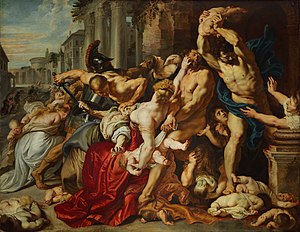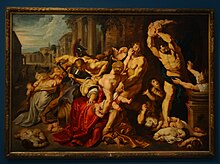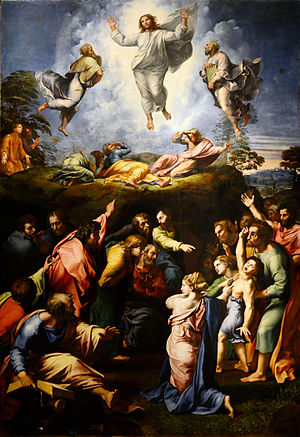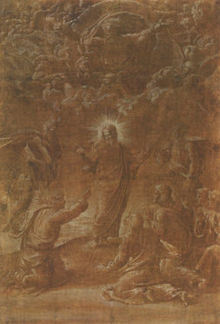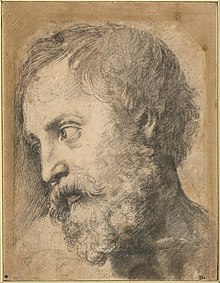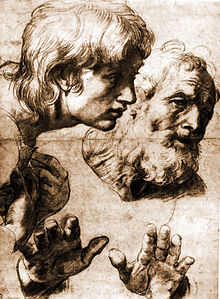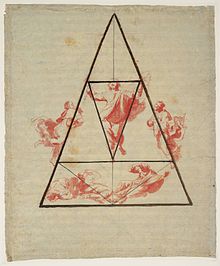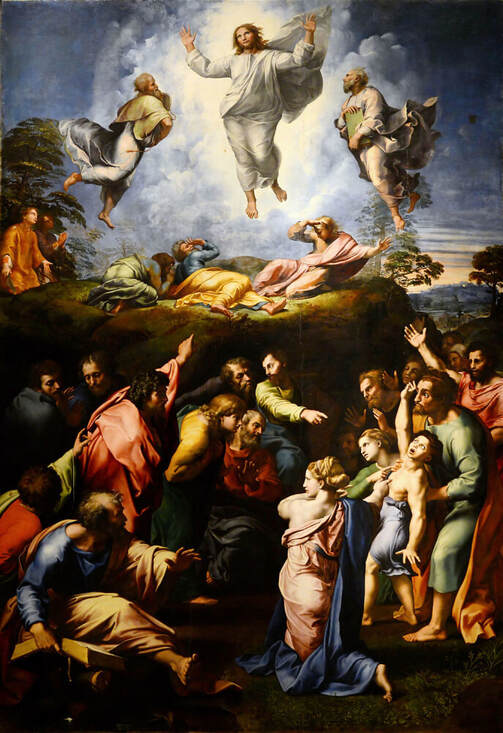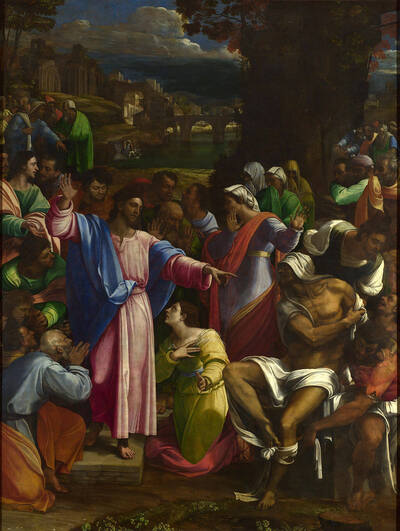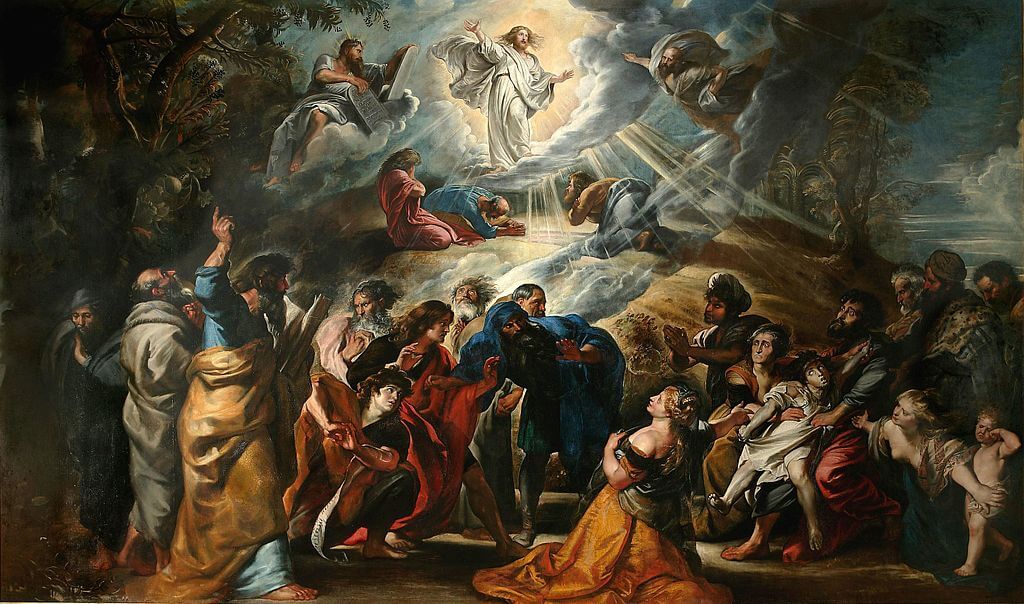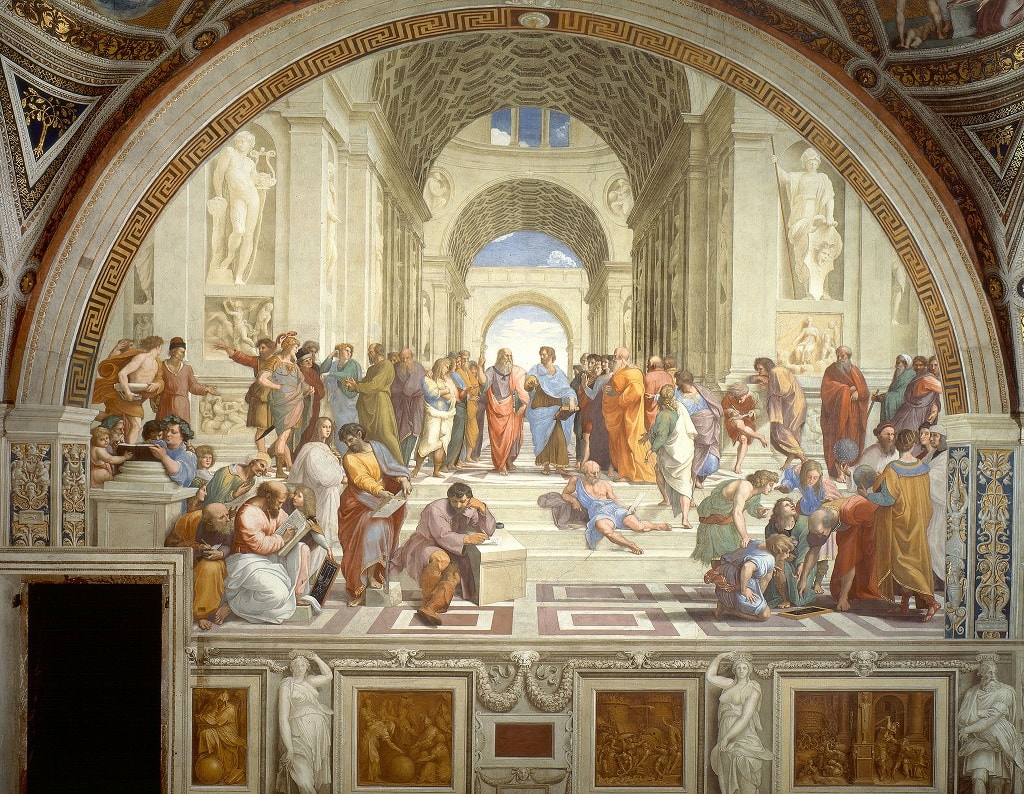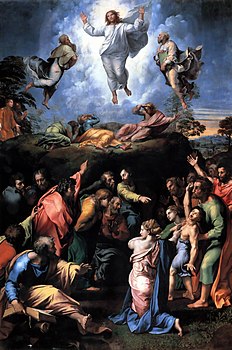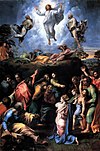Le Massacre des Innocents (Rubens)
| Artiste | Pierre Paul Rubens |
|---|---|
| Date | 1611–12 |
| Type | Peinture sur bois |
| Technique | Peinture |
| Dimensions (H × L) | 142 × 182 cm |
| Propriétaire | Kenneth Thomson Collection |
| Localisation | Musée des beaux-arts de l'Ontario, Toronto (Canada) |
| Artiste | Pierre Paul Rubens |
|---|---|
| Date | Entre 1636 et 1638 |
| Type | Peinture sur bois |
| Technique | Peinture |
| Dimensions (H × L) | 199 × 302 cm |
| Localisation | Alte Pinakothek |
Le Massacre des Innocents est le nom et le sujet de deux peintures de Pierre Paul Rubens représentant l'épisode biblique du massacre des Innocents à Bethlehem, tel qu'il est décrit dans l'Évangile selon Matthieu.
Le chef-d'œuvre perdu[modifier | modifier le code]
La première version peinte par Rubens date de 1611–12. Au xviie siècle, l'œuvre faisait partie de la collection du Liechtenstein Museum à Vienne en Autriche, avec un autre chef-d'œuvre de Rubens, Samson et Dalila. En 1767, le peintre Vincenzio Fanti omit l'œuvre de Rubens de son catalogue du Liechtenstein Museum, puis il fut attribué à l'un des assistants de Rubens, le peintre flamand Jan van den Hoecke. Le tableau est resté dans le musée jusqu'en 1920 lorsqu'une famille autrichienne en fit l'acquisition. Il fut ensuite prêté en 1923 au Stift Reichersberg, un monastère Augustins du nord de l'Autriche.
En 2001, l'expert en peinture flamande et allemande, George Gordon, vit le tableau lors d'une vente chez Sotheby's à Londres. Alors qu'il n'était tenu jusque-là que pour le travail d'un élève de Rubens, cet expert fut persuadé qu'il s'agissait bien d'une œuvre du maître lui-même en raison de la similarité de ses caractéristiques et de son style avec le tableau Samson et Delilah que Rubens réalisé à la même période. L'œuvre fut vendu lors de la vente aux enchères de Sotheby's, le pour 49,5 millions de livres sterling, soit environ 62,5 millions d'euros1, à un homme d'affaires et collectionneur d'art canadien, Kenneth Thomson. Il s'agissait à l'époque du plus cher tableau ancien jamais vendu aux enchères2.
Après la vente, l'œuvre fut prêtée à la National Gallery pendant un certain temps puis, en 2008, elle fut transférée au Musée des beaux-arts de l'Ontario à Toronto à laquelle Kenneth Thomson fit donation du tableau3.
Analyse[modifier | modifier le code]
Le tableau montre la mise à mort des enfants juifs sur les ordres du roi Hérode, désireux d'empêcher l'avènement du Messie. Rubens peint les assassins qui piétinent et poignardent les enfants et leurs mères de manière cruelle mais aussi sensuelle. Il dépeint ce crime atroce comme une fête galante ou une chasse au fauve, montrant ainsi sa maîtrise du dessin, de la composition et du coloris.
Cette œuvre est généralement considérée comme la démonstration de l'apprentissage et de l'enseignement artistique que Rubens tira de son voyage en Italie entre 1600 et 1608, où il observa le travail des peintres italiens baroques comme Le Caravage. Ces influences sont visibles dans ce tableau par le drame pur et le dynamisme émotionnel de la scène, ainsi que la richesse des couleurs. L'œuvre met également en évidence l'utilisation de la technique du clair-obscur.
Version ultérieure[modifier | modifier le code]
À la fin de sa vie, entre 1636 et 1638, Rubens réalisa une seconde version du Massacre des Innocents. Le tableau fut acquis par l'Alte Pinakothek de Munich en 1706, où il est exposé aujourd'hui encore4.
Une copie de cette seconde version a été réalisée sous forme d'estampe par le peintre Paulus Pontius en 1643.
===========================================================================
Massacre of the Innocents (Rubens)
The Massacre of the Innocents is the subject of two paintings by Peter Paul Rubens depicting the episode of the biblical Massacre of the Innocents of Bethlehem, as related in the Gospel of Matthew (2:13-18). The first, measuring 142 x 182 cm, was painted after his return to his native Antwerp in 1608, following eight years spent in Italy.[1]
The lost painting[edit]
The first version painted by Rubens dates from around 1611–12.[2][3] At the end of the seventeenth century, the painting became part of the Liechtenstein Collection in Vienna, Austria, along with another Rubens painting, Samson and Delilah. The Forchondt brothers sold both paintings to Hans-Adam I, Prince of Liechtenstein whom they knew through his father Karl Eusebius, Prince of Liechtenstein around 1700.[4] The paintings were given the Liechtenstein family seal and are recorded in the collection until the 19th century, where drawings in 1815 show they hung side by side in the Garden Palace in Vienna.[4]
After being catalogued by Vincenzio Fanti as a Franciscus de Neve (II) in 1767,[5] the Massacre was attributed in an anonymous inventory of the Liechtenstein Collection dated 1780 to one of Rubens' assistants, Jan van den Hoecke, after Rubens. Under that attribution it remained until it was sold to an Austrian family in 1920. It was subsequently loaned in 1923 to Stift Reichersberg, a monastery in northern Austria.
In 2001, the painting was seen by George Gordon, an expert in Flemish and Dutch paintings at Sotheby's in London. He was persuaded that it was indeed a Rubens by its similar characteristics and style to the Samson and Delilah painted around the same time. The work was sold at auction at Sotheby's, London on July 10, 2002 for £49.5 million (C$117 million)[6][7] to Canadian businessman and art collector Kenneth Thomson, 2nd Baron Thomson of Fleet.
Following the auction the painting was loaned to the National Gallery, London for a period before its transfer in 2008 to the Art Gallery of Ontario in Toronto, to whom Thomson had donated it, and which was undergoing a major rebuilding and expansion during those years.[8]
The composition was already known from what is now seen as a copy by Rubens' workshop. This was bought in 1902 by the Royal Museums of Fine Arts of Belgium in Brussels as a work by Antoon Sallaert.
Analysis[edit]
It is widely regarded as a demonstration of the artist's learnings from his time spent in Italy between 1600 and 1608, where he observed first-hand the works of Italian Baroque painters like Caravaggio. These influences are seen in this painting through the sheer drama and emotive dynamism of the scene, as well as the rich colour. There is also evidence of the use of chiaroscuro. He also used écorché figures - anatomical statues with the skin[9] removed-to study how the body was made.
Context[edit]
At the time of Rubens' first painting on the subject Antwerp had been involved in warfare only a few years before- a conflict temporarily frozen by the truce of 1609. In one year alone over 8,000 citizens had been killed by Calvinists and Catholics alike as the Spanish forces ruling the Netherlands sought to repel Protestant armies. Massacres were a reality in Antwerp; 160 kilometres (100 mi) north of the city the Protestant rebel leader Prince Mauritz commissioned Cornelis van Haarlem to paint the same scene for Haarlem's town hall,- propaganda intended to tell of Spanish atrocities against the Dutch people. Antwerp however remained a Catholic stronghold and became a leading centre of Counter Reformation thought.[10]
Later version[edit]
Towards the end of his life, between 1636 and 1638, Rubens painted a second version of the Massacre of the Innocents.[11] This version was acquired by the Alte Pinakothek, Munich by 1706, where it remains.[12]
A copy of this later version was made as an engraving in 1643 by Paulus Pontius.[13]
Sa connaissance de l’art de la Renaissance italienne est tout aussi manifeste. Rubens s’est inspiré du Christ de Michel-Ange sur sa toile de la Résurrection pour les traits du soldat sur le point de massacrer un enfant à droite. Mais alors que le Christ de Michel-Ange triomphe de la mort, le soldat de Rubens en est l’instrument. La plus célèbre représentation du massacre des innocents à l’époque de Rubens était sans doute une gravure de Marcantonio Raimondi d’une œuvre de Raphaël. En comparaison avec la gracieuse composition de Raphaël, l’interprétation de Rubens est plus réaliste et donc plus tragique. Il semble que Rubens ait également puisé chez les maîtres d’Anvers. La composition diagonale de l’architecture à l’arrière-plan montre des similitudes avec celles du peintre anversois Frans Floris.LA MAISON RUBENS EXPOSE DEUX CHEFS D’ŒUVRE DE JEUNESSE DE RUBENS ET VAN DYCKLe Massacre des Innocents à Bethléem et un portrait de l’apôtre MathieuLa Maison Rubens expose cet automne deux prêts exceptionnels. Le Massacre des Innocents à Bethléem, une œuvre de jeunesse de Rubens (1577-1640) et le Rubens le plus cher au monde, peut être admiré à la Maison Rubens à partir du 26 septembre. Le musée expose également une œuvre de jeunesse d’Antoine van Dyck (1599-1641), l’élève le plus doué de Rubens. La Fondation Roi Baudouin lui a confié ce portrait de Mathieu en prêt permanent. C’est le seul panneau de la célèbre Série Böhler dans une collection publique belge.Rubens: le Massacre des InnocentsLe monumental Massacre des Innocents de Rubens, une des pièces maîtresses du musée canadien The Art Gallery of Ontario, revient pour un temps sur le site où il a été peint. Il s’agit d’une œuvre de jeunesse de Rubens qui est rapidement entrée dans de prestigieuses collections. On l’avait attribuée à divers maîtres depuis le 18e siècle, mais en 2001, des spécialistes ont clairement identifié la main de Rubens dans le style baroque. La nouvelle de la découverte d’un tableau de Rubens a fait le tour du monde et l’œuvre d’art a été vendue en vente. Sa mise aux enchères chez Sotheby’s en 2002 a atteint le prix record de 49,50 millions de livres sterling. Le Massacre des Innocents devenait ainsi le tableau du maître le plus cher de tous les temps. Il fut acheté par l’homme d’affaires et collectionneur canadien Ken Thomson, qui en fit don à la Art Gallery of Ontario. La toile n’avait pas encore voyagé depuis son arrivée au musée de Toronto en 2008. Le Massacre des Innocents est encore à ce jour le tableau le plus cher de Rubens.Scène bibliqueLe tableau évoque un épisode de la Bible, le moment où le roi Hérode apprend la naissance de Jésus. Un oracle lui ayant prédit qu’un nouveau roi naîtrait à Bethléem, il fait tuer tous les garçons de moins de deux ans. Les parents de Jésus fuient en Egypte et l’Enfant Jésus échappe ainsi à un sort cruel. Le massacre des innocents était un thème populaire dans la peinture. Les artistes de la Renaissance en particulier étaient fascinés par l’Antiquité et reproduisirent souvent cet épisode de la Bible.Références à l’Antiquité et à la RenaissanceRubens produisit sa version de l’épisode biblique vers 1610, peu après son retour d’Italie. La scène déborde de dramatisme et de violence et les nombreuses références à l’art antique et à la Renaissance italienne démontrent que le jeune Rubens a déjà toutes les qualités d’un peintre érudit. Rubens s’inspire par exemple pour la mère accroupie de la Vénus antique dans la collection de la famille Gonzague à Mantoue, où il a étudié à la Cour. Le soldat levant son glaive pour transpercer une vieille femme au centre de la composition est emprunté aux Lutteurs, une statue que Rubens a vu à la Villa Médicis à Rome. Le soldat dont la jeune femme à demi-nue tente d’arracher les yeux est emprunté au célèbre groupe du Laocoon, dont Rubens fit un croquis en 1602 lors de sa visite des collections papales au Vatican. Les corps blêmes des enfants massacrés montrent de grandes similitudes avec le marbre de trois putti endormis que Rubens avait vu à Rome à la Villa Borghèse.
Étude d’une œuvre : Le Massacre des Innocents, Nicolas Poussin

Après un an de restauration, en 2016, le chef-d’œuvre de Nicolas Poussin, débarrassé de ses vernis blanchis, a regagné sa cimaise au musée Condé de Chantilly, où il fait l’objet d’une exposition.
C’est une œuvre à part dans la production du peintre, une œuvre unique, pourrait-on dire, à caractère « expérimental ». Elle est datée par le spécialiste Pierre Rosenberg de 1627-1628, soit la période où l’artiste, arrivé à Rome en 1624 (où il passera le reste de sa vie, hormis un passage à Paris de 1640 à 1642), tente de s’imposer sur la scène artistique romaine. Avec succès, puisque, dès 1628, il décroche la commande d’un grand retable pour la basilique Saint-Pierre, honneur suprême pour un peintre ! Notre tableau, quant à lui, fut commandé par le marquis Vincenzo Giustiniani pour le décor de son palais romain. Le choix du thème repose sans doute sur des raisons personnelles : en 1564, vingt jeunes gens de la famille Giustiniani avaient été enlevés, convertis de force et, pour certains, tués par les Ottomans. La collection du marquis comptait un autre grand Massacre des Innocents, dû à Cornelisz Schut, ce qui démontre bien l’importance que le sujet revêtait à ses yeux. Giustiniani était un grand collectionneur, il possédait des œuvres de Caravage. Peindre un tableau pour lui, c’était s’exposer aux yeux des cercles d’amateurs les plus éclairés ; l’enjeu était important et nul doute que Poussin ait voulu ici prouver ses capacités d’invention.



